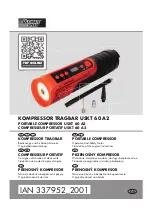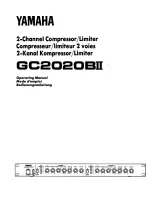
10
The low-pressure switch must be suitable for the applied refrig-
erant, and the switch must be manually resettable and open when
the pressure falls below vacuum. The switch is a manual reset
type that can be reset after the pressure has once again risen
above 1.7 bar (25 psia). It is critical that the switch be a manual
reset type to prevent the compressor from short cycling in the re-
verse direction.
If a switch is not available, a manifold gage connected to the dis-
charge housing of the compressor BEFORE THE DISCHARGE
CHECK VALVE can be used. If the compressor can be “bumped”
or “jogged” very quickly (<1 second) while someone is watching
the gage, compressor rotation can be determined without damage
to the compressor. If the pressure drops, the compressor is rotating
backwards and will have to be rewired. If the pressure goes up, the
compressor is spinning in the correct direction.
REFRIGERATION SYSTEM DESIGN CONSIDERATIONS
In order to eliminate the possibility of refrigerant migrating into
the oil separator and compressor, Carlyle recommends the appli-
cation of a positive-seal, discharge check valve to be installed in
the discharge line after the oil separator.
Certain operating conditions may result in motor temperatures
and/or discharge gas temperatures that exceed the recommended
operating parameters.
Carlyle's Solutions software can be used to estimate the discharge
temperature for a given application.
Carlyle requires that some form of liquid injection be applied to
control/reduce motor and discharge gas temperatures to be within
recommended guidelines.
Motor cooling valves are available through Carlyle, and they
should be applied to inject liquid into the compressor suction line.
For 06Z screw compressor applications, this injection is accom-
plished using a motor cooling valve that injects liquid into the suc-
tion line entering the compressor.
Carlyle also offers de-superheating valves. These valves inject liq-
uid at the economizer line or economizer port to assist in con-
trolling discharge gas temperatures. For screw compressor appli-
cations, discharge gas temperature control is accomplished using a
de-superheating valve that injects liquid into the economizer port
or the economizer line.
Because refrigerant injection for discharge gas cooling eventually
flows into the screw rotor chamber after the suction gas is trapped,
compressor capacity is not significantly affected.
Carlyle recommends the application of our qualified Control
Module package (P/N 6BSB000929), which provides the follow-
ing safety control functionality:
• Discharge Temperature Monitoring
• Oil Level Monitoring
• Oil Flow-Rate/Supply Monitoring
Table 3 — Control Points Summary
REVERSE ROTATION / OPERATION WITH SUCTION PRESSURE IN VACUUM
• Control must detect and prevent reverse rotation of the compressor within 1 second of compressor start-up.
• Compressor must not operate in a vacuum, as measured at the suction pressure port, for greater than 1 minute.
OIL PRESSURE CONFIRMATION / SAFETY
• Three pressures must be observed to ensure that the oil pressure is suitable for compressor operation: suction, discharge, and oil.
• Oil pressure safety control must be manually reset.
• Oil pressure must be maintained as follows:
1.
P
OIL
> [0.7 x (
P
DISCHARGE
–
P
SUCTION
) +
P
SUCTION
]
2.
P
OIL
> [
P
SUCTION
+ 1.0 bar] 75 seconds after start
OIL SUPPLY CONFIRMATION / OIL LEVEL SWITCH
• Oil supply to the compressor must be maintained during operation at all times.
• Compressor operation must be stopped if the required oil level switch is open for 5 continuous seconds.
• Oil supply solenoid valve must be closed during OFF cycles.
OIL FILTER DIFFERENTIAL PRESSURE
•
Compressor operation must be stopped if the pressure differential measured between the entering and leaving oil filter locations exceeds 30psid
.
• The oil filter supply tubing design should apply valves to allow for the isolation and replacement of the filter without removing the system refrigerant
charge.
MOTOR TEMPERATURE LIMITATION
• Motor temperatures must be continuously monitored during compressor operation.
• Motor temperatures must not exceed 275°F (135°C).
COMPRESSOR SHORT CYCLING
• Control must provide for a 10-minute minimum time delay before restarting the 06Z compressor.
•
The maximum number of compressor START cycles per hour is 6
.
MAXIMUM DISCHARGE GAS TEMPERATURE
• Discharge gas temperatures must not exceed 210°F (99°C).
• Control must prevent compressor operation when discharge gas temperatures exceed this maximum.
MAXIMUM OIL TEMPERATURE
• Oil temperatures must not exceed 210°F (99°C).
• Control must prevent compressor operation when oil temperatures exceed this maximum.
RUN-PROOF
• Current must be monitored to detect welded contacts on a contactor or single-phase condition.
• Oil flow must be resumed if a contactor is determined to be welded shut.
• Compressor must be shut down if a single-phase condition is detected.
LIQUID LINE SOLENOID / ECONOMIZER
• A liquid line solenoid valve is required to shut off liquid flow to the compressor during OFF cycles.
• Controlling this valve allows for additional capacity reduction during low load conditions.
• Economizer refrigerant mass flow cannot exceed 30% of the suction mass flow.
Summary of Contents for 06ZCE1H3AA06013
Page 3: ...3 Fig 2 Compressor Physical Data and Connections 06ZC Frame 1...
Page 4: ...4 Fig 2 Compressor Physical Data and Connections 06ZC Frame 1 cont...
Page 5: ...5 Fig 3 Compressor Physical Data and Connections 06ZF Frame 2...
Page 6: ...6 Fig 3 Compressor Physical Data and Connections 06ZF Frame 2 cont...
Page 7: ...7 Fig 4 Compressor Physical Data and Connections 06ZJ Frame 3...
Page 17: ...17 Fig 13 Compressor Connection Details Fig 14 Sample Compressor Motor Voltage Curves...
Page 22: ......
Page 23: ......










































